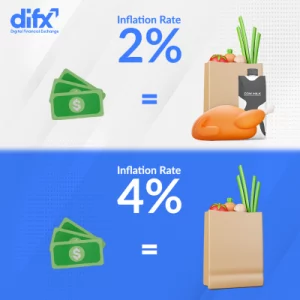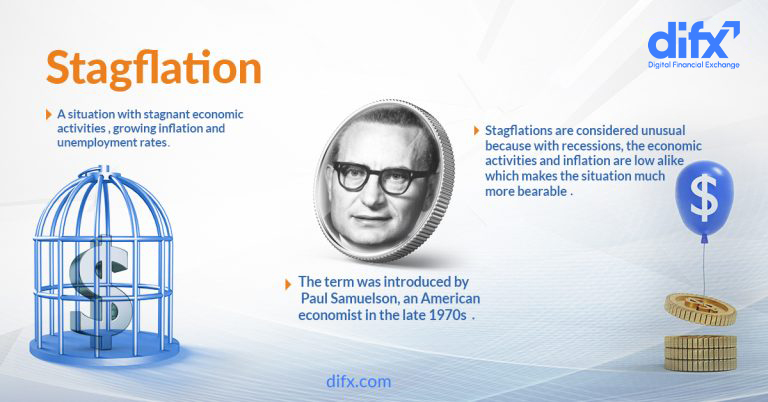Inflation is an economic condition where we experience a constant increase in the price of goods and services. In other words, the buying power of the currency of your country is decreasing, meaning you have to pay more to buy the same items you bought, let’s say, a month ago.
Inflation can take an extreme form, called Hyperinflation when the prices may rise sharply on daily basis!
In this article, we will talk about inflation and the ways that it can be controlled, and explore some real-life examples of inflation.

Inflation is an economic phenomenon where the prices of goods and services would increase constantly. In simple terms, in an economy with high inflation, you can fill your basket with fewer items than a month ago because the purchasing power of your country’s currency is decreasing.
Inflation allows us to see the price change of a diversified set of goods and services within a specific period of time. We are paying for things like food, electricity, and transportation almost every day, and inflation shows us how much more we have to pay for all these services with a single number.
Inflation can be calculated in different ways. In the United States, for instance, the Consumer Price Index (CPI) is used to measure the price increase of a selected basket of goods and services that are put together based on the consumers’ spending habits.
Inflation occurs when the money supply of a country is increased rapidly by the authorities. We can explain inflation by Monetarism, an economic theory that believes the economy of a country can be controlled and managed by changing its supply of money.
We can categorize the causes of inflation into 3 categories:
In this case, the money supply has increased but the production rate has stayed the same. In other words, people have more money to spend but the supply of goods and services has not increased at the same rate. The demand increases as people want to buy more, leading to an increase in prices.
The increase in the supply of money can lead to higher prices, including the price of goods that are used in the production of other items. In other words, the production cost of other goods will increase, leading to a higher end price for goods and services.
This is when people expect prices to continue to go up. They will expect their salaries to be increased because of this expectation which in turn, will increase the production cost of other goods and services, leading to higher prices again.
The financial authority of a country, like the central bank, is the main regulatory body responsible for controlling inflation. This is mostly done through Monetary Policy, a set of plans and strategies that aim to maintain the money supply of the economy.
As we explained, inflation is mainly caused by the extreme increase in the money supply. The first solution that comes to mind then would be to somehow decrease this supply. In this case, the financial authority would follow a Contractionary approach in its monetary policy, doing exactly the same.
One way for fighting inflation is by increasing the interest rate which promotes people to keep their money in banks as they would be able to earn more interest on their savings. This leads to less money in the economy, decreasing economic activities to some extent and helping with slowing down the high increase in prices.
By raising the interest rate, the central bank makes borrowing more expensive to slow economic activities down. With higher interest rates, investors tend to exit high-risk asset classes like crypto and stocks and invest more in safe-haven assets.
As the name may suggest, hyperinflation is an extreme case of regular inflation when the prices are increasing intensely. Usually, when the monthly inflation rate exceeds 50%, the economy is going through a hyperinflation phase. However, the increase would usually not stop at 50 and would rise at a rate that may lead to the total destruction of the national currency.
Yugoslavia, Zimbabwe, Germany, Venezuela, and Hungary are some of the countries that experienced hyperinflation or are currently going through one.

Created by combining the words “stagnation” and “inflation”, Stagflation is an economic situation when economic activities are stagnant while the unemployment rate and inflation rate are growing.
The term was popularized by Paul Samuelson, a Nobel-winner American economist in the late 1970s. Stagflations are considered unusual because, with a recession, the economic activities and inflation are low alike which makes the situation much more bearable.
Bitcoin was proposed as a new monetary system that will be immune to inflation. Bitcoin has a limited supply of 21 million coins, meaning its supply will never exceed this number. Additionally, Bitcoin’s system ensures that this supply would enter the market gradually. We will have all the 21 million bitcoins around the year 2140.
Based on the model, in addition to a fixed supply, the available supply of bitcoin accessible to the public will increase slowly, making sure that an increase in demand will lead to an increase in the price of the asset.
This system has convinced many investors that Bitcoin can act as a hedge against inflation that is common among fiat currencies like the US Dollar or British Pound.